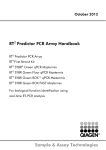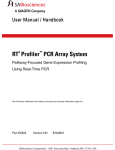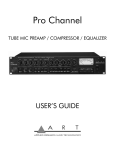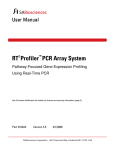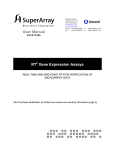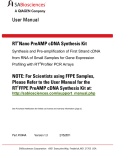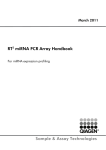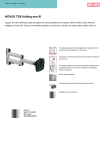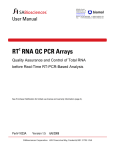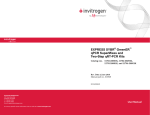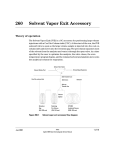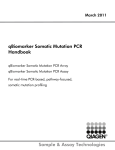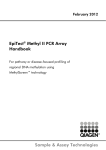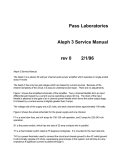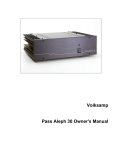Download Sample & Assay Technologies RT2 qPCR Primer
Transcript
March 2011 RT2 qPCR Primer Assay Handbook For gene expression analysis by real-time RTPCR Sample & Assay Technologies QIAGEN Sample and Assay Technologies QIAGEN is the leading provider of innovative sample and assay technologies, enabling the isolation and detection of contents of any biological sample. Our advanced, high-quality products and services ensure success from sample to result. QIAGEN sets standards in: Purification of DNA, RNA, and proteins Nucleic acid and protein assays microRNA research and RNAi Automation of sample and assay technologies Our mission is to enable you to achieve outstanding success and breakthroughs. For more information, visit www.qiagen.com. Contents Kit Contents 4 Shipping and Storage 4 Product Use Limitations 4 Product Warranty and Satisfaction Guarantee 4 Technical Assistance 5 Safety Information 5 Quality Control 5 Introduction 6 Principle and procedure 6 Description of protocols 6 Equipment and Reagents to Be Supplied by User 8 Important Notes 9 Preparing a workspace free of DNA contamination 9 RNA preparation, quantification, and quality control 9 Genomic DNA contamination 11 Starting RNA amounts 12 Protocols cDNA Synthesis Using the RT2 First Strand Kit 13 Real-Time PCR Using RT2 qPCR Primer Assays and RT2 SYBR Green Mastermixes 15 Troubleshooting Guide 19 Appendix A: Data Analysis 22 ∆∆CT method 22 Standard curve method 22 References 25 Ordering Information 26 RT2 qPCR Primer Assay Handbook 03/2011 3 Kit Contents RT2 qPCR Primer Assay (200) Catalog no. 330001 Number of 25 μl reactions 200 200 μl RT2 qPCR Primer Assay (10 μM) in a single tube 1 tube Shipping and Storage The RT2 qPCR Primer Assays are shipped at ambient temperature but must be stored at –20°C upon arrival. When stored under these conditions and handled correctly, the product can be kept for at least 6 months from date of receipt without reduction in performance. Product Use Limitations RT2 qPCR Primer Assays are intended for molecular biology applications. These products are not intended for the diagnosis, prevention, or treatment of a disease. All due care and attention should be exercised in the handling of the products. We recommend all users of QIAGEN products to adhere to the NIH guidelines that have been developed for recombinant DNA experiments, or to other applicable guidelines. Product Warranty and Satisfaction Guarantee QIAGEN guarantees the performance of all products in the manner described in our product literature. The purchaser must determine the suitability of the product for its particular use. Should any product fail to perform satisfactorily due to any reason other than misuse, QIAGEN will replace it free of charge or refund the purchase price. We reserve the right to change, alter, or modify any product to enhance its performance and design. If a QIAGEN product does not meet your expectations, simply call your local Technical Service Department or distributor. We will credit your account or exchange the product — as you wish. Separate conditions apply to QIAGEN scientific instruments, service products, and to products shipped on dry ice. Please inquire for more information. A copy of QIAGEN terms and conditions can be obtained on request, and is also provided on the back of our invoices. If you have questions about product specifications or performance, please call QIAGEN Technical Services or your local distributor (see back cover or visit www.qiagen.com). 4 RT2 qPCR Primer Assay Handbook 03/2011 Technical Assistance At QIAGEN, we pride ourselves on the quality and availability of our technical support. Our Technical Service Departments are staffed by experienced scientists with extensive practical and theoretical expertise in sample and assay technologies and the use of QIAGEN products. If you have any questions or experience any difficulties regarding RT2 qPCR Primer Assays or QIAGEN products in general, please do not hesitate to contact us. QIAGEN customers are a major source of information regarding advanced or specialized uses of our products. This information is helpful to other scientists as well as to the researchers at QIAGEN. We therefore encourage you to contact us if you have any suggestions about product performance or new applications and techniques. For technical assistance and more information, please see our Technical Support Center at www.qiagen.com/Support or call one of the QIAGEN Technical Service Departments or local distributors (see back cover or visit www.qiagen.com). Safety Information When working with chemicals, always wear a suitable lab coat, disposable gloves, and protective goggles. For more information, please consult the appropriate material safety data sheets (MSDSs). These are available online in convenient and compact PDF format at www.qiagen.com/Support/MSDS.aspx where you can find, view, and print the MSDS for each QIAGEN kit and kit component. 24-hour emergency information Emergency medical information in English, French, and German can be obtained 24 hours a day from: Poison Information Center Mainz, Germany Tel: +49-6131-19240 Quality Control In accordance with QIAGEN’s Quality Management System, each lot of RT2 qPCR Primer Assays is tested against predetermined specifications to ensure consistent product quality. RT2 qPCR Primer Assay Handbook 03/2011 5 Introduction Real-time RT-PCR is a highly sensitive and reliable method for gene expression analysis for multiple applications, such as the verification of microarray data. Optimal primer design is critical for successful real-time PCR based analysis of gene expression. Carefully designed primers specifically amplify genes of interest, overcoming the challenge of eliminating nonspecific amplification due to the presence of thousands of genes in first-strand cDNA, each potentially available as a PCR template. In addition, primers that provide efficient amplification are important to ensure accurate gene expression results from the commonly used ∆∆CT method, which requires a consistently high degree of amplification efficiency across all experiments. Taking advantage of an experimentally verified, proprietary computer algorithm, QIAGEN has developed high-quality, gene-specific RT2 qPCR Primer Assays for gene expression analyses and microarray data validation. RT2 qPCR Primer Assays are designed for SYBR® Green based, real-time PCR detection. The primer design computer algorithm has been developed using an in vitro assay to ensure that the resulting primer sequences generate a single PCR product of the predicted size and a minimal amount of primer–dimer in 30 cycles of PCR amplification. The assay also ensures that the amplification efficiency of the primers is at least 90%. As a result, the algorithm designs highly effective primer sequences for SYBR Green based real-time PCR detection. RT2 qPCR Primer Assays are available for every human, mouse, rat, rhesus macaque, fruit fly, and dog gene annotated by the NCBI. Principle and procedure For optimal performance, RT2 qPCR Primer Assays should be used together with the RT2 First Strand Kit for cDNA synthesis and RT2 SYBR Green Mastermixes for PCR. These reagents have been formulated and pretested together with RT2 qPCR Primer Assays. The RT2 First Strand Kit includes a proprietary genomic DNA elimination step to remove any residual contamination in RNA samples before reverse transcription, thereby eliminating false positive signals. Each of the real-time instrument-specific RT2 SYBR Green Mastermixes contains SYBR Green and an appropriate reference dye to match the instrumentation available in your laboratory. RT2 SYBR Green Mastermixes are available for all real-time PCR instruments from QIAGEN, Applied Biosystems, Bio-Rad, Stratagene, Eppendorf, Roche, and other major suppliers. Description of protocols This handbook contains 2 protocols. The first protocol details cDNA synthesis by reverse transcription using purified RNA and the RT2 First Strand Kit (page 13). This protocol should be performed prior to real-time PCR. The second protocol 6 RT2 qPCR Primer Assay Handbook 03/2011 describes how to perform real-time PCR using the cDNA prepared in the first protocol as template (page 15). RT2 qPCR Primer Assay Handbook 03/2011 7 Equipment and Reagents to Be Supplied by User When working with chemicals, always wear a suitable lab coat, disposable gloves, and protective goggles. For more information, consult the appropriate material safety data sheets (MSDSs), available from the product supplier. RT2 First Strand Kit (cat. no. 330401) RT2 SYBR Green Mastermix suitable for use with your real-time cycler. RT2 SYBR Green Mastermixes available include: RT2 SYBR Green qPCR Mastermix: suitable for use with real-time cyclers that do not require a reference dye, including: Bio-Rad® models CFX96™, CFX384™; Bio-Rad/MJ Research models Chromo4™, DNA Engine Opticon® 2; Roche® LightCycler® 480 (96-well and 384-well) RT2 SYBR Green Fluor qPCR Mastermix: suitable for use with the following real-time cyclers: Bio-Rad models iCycler®, iQ™5, MyiQ™, MyiQ2 RT2 SYBR Green ROX™ qPCR Mastermix: suitable for use with the following real-time cyclers: Applied Biosystems® models 5700, 7000, 7300, 7500 (Standard and Fast), 7700, 7900HT (Standard and Fast 96-well block, 384-well block), StepOnePlus™, ViiA™ 7 (Standard and Fast 96-well block, 384-well block); Eppendorf® Mastercycler® ep realplex models 2, 2S, 4, 4S; Stratagene® models Mx3000P®, Mx3005P®, Mx4000®; Takara TP-800 RT2 SYBR Green ROX FAST Mastermix: suitable for use with the Rotor- Gene® Q and other Rotor-Gene cyclers Purified RNA samples Real-time PCR cycler High-quality, nuclease-free water. Do not use DEPC-treated water. Nuclease-free pipet tips and tubes Optional: XpressRef Universal Total RNA to control PCR conditions is available for human (cat. no. 338112), mouse (cat. no. 338114), and rat (cat. no. 338116). 8 RT2 qPCR Primer Assay Handbook 03/2011 Important Notes Preparing a workspace free of DNA contamination For accurate and reproducible PCR array results, it is important to avoid contamination of the assay with foreign DNA. Any DNA contamination will artificially inflate the SYBR Green signal, yielding skewed gene expression profiles and false-positive signals. The most common sources of DNA contamination are the products of previous experiments spread into the air of the working environment. To set up and maintain a working environment free of DNA contamination, follow the guidelines below. Wear gloves throughout the procedure. Use only fresh PCR-grade reagents (water) and labware (tips and tubes). Physically separate the workspaces used for PCR setup and post-PCR processing or non-PCR operations. Decontaminate the PCR workspace and labware (pipettor barrels, tube racks, etc.) before each use with UV light (to render any contaminating DNA ineffective in PCR through the formation of thymidine dimers) or with 10% bleach (to chemically inactivate and degrade any DNA). Close all tubes containing PCR products once you are finished adding or removing volumes. Before discarding any labware (tips or tubes) containing PCR products or other DNA, treat with 10% bleach. Do not leave labware (tubes and tip boxes) exposed to the air for long periods of time. RNA preparation, quantification, and quality control The most important prerequisite for any gene expression analysis experiment is consistent, high-quality RNA from every experimental sample. Residual traces of proteins, salts, or other contaminants may degrade the RNA or decrease the efficiency of enzyme activities necessary for optimal reverse transcription and real-time PCR performance. Recommended RNA preparation methods High quality total RNA for your real-time PCR experiment should be prepared using one of the methods described below, depending on the biological sample. For optimal results, RNA samples should be suspended in RNase-free water. Do not use DEPC-treated water. Cultured cells We recommend the RNeasy® Mini Kit (cat. no. 74104) for RNA purification from cultured cells. It is important to perform the on-column DNase digestion step RT2 qPCR Primer Assay Handbook 03/2011 9 described in the RNeasy Mini Handbook (using the RNase-Free DNase Set [cat. no. 79254]). Tissue samples We recommend the RNeasy Microarray Tissue Mini Kit (cat. no. 73304) including the optional on-column DNase digestion step described in the RNeasy Microarray Tissue Handbook (using the RNase-Free DNase Set [cat. no. 79254]). Formalin-fixed paraffin-embedded (FFPE) samples We recommend the RNeasy FFPE Kit (cat. no. 73504) for RNA purification from FFPE samples. Small samples yielding <100 ng total RNA We recommend the RNeasy Micro Kit (cat no. 74004) for RNA purification from small samples. Whole blood samples We recommend the PAXgene® Blood RNA Kit (cat. no. 762174) for preparation of total RNA from whole blood samples. Alternatively, the QIAamp® RNA Blood Mini Kit (cat. no. 52304) can also be used for this purpose. Total RNA isolated using a phenol-based method Total RNA from any biological source material prepared using a phenol-based method (e.g., QIAzol® Lysis Reagent, TRIzol® Reagent, RNAzol® Reagent) should be further purified using the RNeasy Mini Kit. It is important to perform the oncolumn DNase digestion step described in the RNeasy Mini Handbook. Other biological samples Refer to the existing literature to find protocols for high-quality RNA purification from other biological samples or contact QIAGEN Technical Service. RNA quantification and quality control For best results from the RT2 qPCR Primer Assays, all RNA samples should also demonstrate consistent quality according to the following criteria. Concentration and purity determined by UV spectrophotometry The concentration and purity of RNA should be determined by measuring the absorbance in a spectrophotometer. Prepare dilutions and measure absorbance 10 RT2 qPCR Primer Assay Handbook 03/2011 in 10 mM Tris·Cl,* pH 8.0. The spectral properties of nucleic acids are highly dependent on pH. An absorbance reading of 1.0 at 260 nm in a 1 cm detection path corresponds to an RNA concentration of 40 μg/ml. A260:A230 ratio should be greater than 1.7 A260:A280 ratio should be 1.8 to 2.0 Concentration determined by A260 should be >40 μg/ml Ribosomal RNA band integrity Run an aliquot of each RNA sample on a denaturing agarose gel or the Agilent® Bioanalyzer using an RNA 6000 Nano LabChip®. Verify that there are sharp bands/peaks present for both the 18S and 28S ribosomal RNAs (Figure 1). Any smearing of the RNA bands or shoulders on the RNA peaks indicate that degradation has occurred in the RNA sample. A B Figure 1. Ribosomal RNA integrity. A Agilent Bioanalyzer electropherogram of high-quality total RNA showing sharp peaks for the 18S (left) and 28S (right) ribosomal RNA. Due to high quality of the RNA, peaks do not have shoulders (especially to the left of each peak). B Agarose gel electrophoresis shows sharp bands (especially at the bottom of each band) for 28S and 18S ribosomal RNA. Genomic DNA contamination Eliminating genomic DNA contamination is essential for obtaining optimal realtime gene expression results using RT2 qPCR Primer Assays. Use of a no reverse transcription (NRT) control, in which reverse transcriptase is replaced with water in the cDNA synthesis reaction, is the most accurate way to detect DNA contamination. If the difference in CT values between the NRT control and a complete reaction for the same gene of interest is greater than 6, then any DNA * When working with chemicals, always wear a suitable lab coat, disposable gloves, and protective goggles. For more information, please consult the appropriate material safety data sheets (MSDSs), available from the product supplier. RT2 qPCR Primer Assay Handbook 03/2011 11 contamination will not affect the reliability of the relative gene expression analysis. To remove any residual contamination from your RNA samples, we strongly recommend RNA purification using the RNeasy Mini Kit including the optional on-column DNase digestion step, followed by cDNA synthesis using the RT2 First Strand Kit. If required, individual, species-specific RT2 qPCR Primer gDNA Controls are available. Starting RNA amounts RT2 qPCR Primer Assays provide results with as little as 25 ng or as much as 5 μg total RNA per cDNA synthesis reaction. For smaller starting RNA amounts, the RT2 PreAMP cDNA Synthesis Kit (cat. no. 330451) enables gene expression analysis from as little as 1 ng total RNA or 100 ng RNA from FFPE samples by preamplifying first strand cDNA. This allows gene expression analysis from samples such as fine needle biopsy samples, laser captured microdissection samples, stem cell clusters or embryoid bodies, FACS® generated cells, or FFPE samples. For more details, see the RT2 PreAMP cDNA Synthesis Handbook. The optimal amount of starting material depends on the relative abundance of the transcripts of interest. Lower abundance transcripts require more RNA; higher abundance transcripts require less RNA. Greater amounts of input total RNA yield a greater number of positive calls (i.e., genes expressed in the linear dynamic range of the method). Lower amounts of input total RNA yield a smaller number of positive calls. For successful results, we recommend that first-time users start with 0.5 μg to 1 μg of total RNA. It is important to use a consistent amount of total RNA for all reactions in a single experiment. 12 RT2 qPCR Primer Assay Handbook 03/2011 Protocol: cDNA Synthesis Using the RT2 First Strand Kit Important points before starting Use the same amount of total RNA for reverse transcription of each sample to be analyzed. First-time users are recommended to start with 0.5–1 μg total RNA. Use of less than 100 ng RNA will result in a high rate of false negatives. Do not use DEPC-treated water. Use high-quality, nuclease-free water. The RT2 First Stand Kit is not compatible with the chemicals in DNA-free™ kits from Ambion. If your RNA sample has been treated with DNA-free reagents, contact QIAGEN Technical Service. Procedure 1. Briefly centrifuge the reagents of the RT2 First Stand Kit (10–15 s) to bring the contents to the bottom of the tubes. 2. Prepare the genomic DNA elimination mix for each RNA sample in a sterile PCR tube according to Table 1. Mix gently by pipetting up and down and then centrifuge briefly. Table 1. Genomic DNA elimination mix Component RNA Buffer GE RNase-free water Total volume Amount 25 ng–5 μg 2 μl Variable 10 μl 3. Incubate the genomic DNA elimination mix for 5 min at 42°C, then place immediately on ice for at least 1 min. RT2 qPCR Primer Assay Handbook 03/2011 13 4. Prepare the reverse-transcription mix according to Table 2. Table 2. Reverse-transcription mix Component Volume for 1 reaction Volume for 2 reactions Volume for 4 reactions 5x Buffer BC3 4 μl 8 μl 16 μl Control P2 1 μl 2 μl 4 μl RE3 Reverse Transcriptase Mix 2 μl 4 μl 8 μl RNase-free water 3 μl 6 μl 12 μl 10 μl 20 μl 40 μl Total volume 5. Add 10 μl reverse-transcription mix to each tube containing genomic DNA elimination mix. Mix gently by pipetting up and down. 6. Incubate at 42°C for exactly 15 min. Then immediately stop the reaction by incubating at 95°C for 5 min. 7. Add 91 μl RNase-free water to each reaction. Mix by pipetting up and down several times. 8. Place the reactions on ice and proceed with the real-time PCR protocol. If you wish to store the reactions prior to real-time PCR, transfer them to a –20°C freezer. For quality control analysis using the RT2 RNA QC PCR Array, follow the protocol in the RT2 RNA QC PCR Array Handbook using a 6 μl aliquot of the diluted cDNA template. 14 RT2 qPCR Primer Assay Handbook 03/2011 Protocol: Real-Time PCR Using RT2 qPCR Primer Assays and RT2 SYBR Green Mastermixes Important points before starting Ensure that the RT2 SYBR Green Mastermix is suitable for your real-time cycler (see page 8). For accuracy and precision, ensure that micropipettors are calibrated before beginning the protocol. Be sure not to introduce bubbles into wells/tubes when pipetting. Do not use DEPC-treated water. Use high-quality, nuclease-free water. If precipitates are present in the Mastermix tubes, warm the reagents at 42°C for 1 min and vortex briefly to dissolve. Repeat if necessary. To ensure that each experimental sample yields a reliably detectable CT value in real-time PCR, we recommend using undiluted cDNA template and a 1:10 dilution of cDNA template in separate reactions. In addition, prepare either duplicate or triplicate reactions for each template at each concentration. For every experimental sample, prepare reactions for every gene of interest and for a single housekeeping gene or a set of housekeeping genes to normalize the raw data. Choose housekeeping gene(s) known to not change their expression under the experimental conditions. Prepare a positive control reaction using template known to represent the genes of interest, such as template generated from XpressRef Universal Total RNA. To control for DNA contamination introduced during reaction setup, prepare a no template control (NTC) reaction replacing template with water. To control for genomic DNA contamination, perform one assay for each gene of interest and each housekeeping gene using an equivalent volume of product from the no reverse transcription (NRT) reaction performed for each RNA sample. Optional: Generate a standard curve for each gene of interest and housekeeping gene(s). To generate a standard curve, prepare a 5-point series of 5- or 10-fold dilutions in duplicate using a template known to represent the genes of interest, such as template generated from XpressRef Universal Total RNA. RT2 qPCR Primer Assay Handbook 03/2011 15 Procedure 1. Briefly centrifuge the RT2 SYBR Green Mastermix, RT2 qPCR Primer Assay, and cDNA synthesis reaction (10–15 s) to bring the contents to the bottom of the tubes. Note: As the RT2 SYBR Green Mastermix contains HotStart DNA Taq Polymerase that is active only after heat activation, reactions can be prepared at room temperature (15–25°C). 2. Prepare the PCR components mix in a 5 ml tube, as described in Table 3. Table 3. PCR components mix for one reaction Component Volume RT2 SYBR Green Mastermix 12.5 μl cDNA synthesis reaction 1 μl RT2 qPCR Primer Assay (10 μM stock) 1 μl RNase-free water Total volume 10.5 μl 25 μl Note: If performing multiple reactions, prepare a mix containing RT2 SYBR Green Mastermix, RT2 qPCR Primer Assay, and RNase-free water by scaling up the volumes shown in Table 3. Prepare 10% more mix than is required to allow for pipetting errors (i.e., for 96 reactions, prepare enough PCR components mix for 106 reactions). Add the mix to the cDNA synthesis reactions using a repeat pipet. 3. Briefly centrifuge the PCR components mix and place the tube(s) into the real-time cycler. If using plates instead of tubes, centrifuge the plate for 1 min at 1000 g to remove bubbles. 4. Program the real-time cycler according to Table 4, 5, or 6, depending on the real-time cycler used. Run the program. Note: For additional help with instrument setup, see our Instrument-Specific Setup Instructions and Protocol Files at: www.SABiosciences.com/pcrarrayprotocolfiles.php. 16 RT2 qPCR Primer Assay Handbook 03/2011 Table 4. Cycling conditions* for Applied Biosystems, Bio-Rad,† Stratagene, and Eppendorf‡ cyclers Cycles Duration Temperature Comments 1 10 min 95°C HotStart DNA Taq Polymerase is activated by this heating step. 40 15 s 95°C 1 min 60°C Perform fluorescence data collection. * Recommended for the following cyclers: Applied Biosystems models 5700, 7000, 7300, 7500, 7700, 7900HT, StepOnePlus, ViiA 7; Bio-Rad models iCycler, iQ5, MyiQ, MyiQ2, CFX96, CFX384; Stratagene models Mx3000P, Mx3005P, Mx4000P; Eppendorf Mastercycler ep realplex models 2, 2S, 4, 4S. † For Bio-Rad models CFX96 and CFX384: adjust the ramp rate to 1°C/s. ‡ For Eppendorf Mastercyler ep realplex models 2, 2S, 4, and 4S: for the Silver Thermoblock, adjust the ramp rate to 26%; for the Aluminum Thermoblock, adjust the ramp rate to 35%. Refer to the Instrument Setup Guide at www.SABiosciences.com/pcrarrayprotocolfiles.php for detailed setup instructions. Table 5. Cycling conditions for Roche cyclers§ § Cycles Duration Temperature Comments 1 10 min 95°C HotStart DNA Taq Polymerase is activated by this heating step. 45 15 s 95°C 1 min 60°C Perform fluorescence data collection. Recommended for the Roche LightCycler 480. If using a Roche LightCycler 480, adjust the ramp rate to 1°C/s. Refer to the “Instrument Setup Guide” at www.SABiosciences.com/pcrarrayprotocolfiles.php for more information on other required changes to settings for Melt Curve Acquisition. RT2 qPCR Primer Assay Handbook 03/2011 17 Table 6. Cycling conditions for Bio-Rad and Takara cyclers and all other cyclers* Cycles Duration Temperature Comments 1 10 min 95°C HotStart DNA Taq Polymerase is activated by this heating step. 40 15 s 95°C 30–40 s 55°C 30 s 72°C Perform fluorescence data collection. Different cyclers need different lengths of time to detect the fluorescent signal. Choose the appropriate time for the annealing step (55°C) for your cycler. * Recommended for the following cyclers: Bio-Rad/MJ Research models Chromo4, DNA Engine Opticon, DNA Engine Opticon 2; Takara TP-800; all other cyclers. 5. Recommended: Perform dissociation (melting) curve analysis to verify PCR specificity. Run a melting curve program and generate a first derivative dissociation curve for each well using the real-time cycler software. A single peak should appear in each reaction at temperatures greater than 80°C. Note: If your instrument does not have a default melting curve program, run the following program instead: 95°C, 1 min; 65°C, 2 min (optics off); 65°C to 95°C at 2°C/min (optics on). Note: For cycler-specific melting curve analysis settings, please refer to the Instrument Setup Guide for your cycler at www.SABiosciences.com/pcrarrayprotocolfiles.php. Note: Reactions can be stored at –20°C wrapped in aluminum foil and melting curve analysis performed at a later time. When ready to perform melting curve analysis, warm the tube to room temperature (15–25°C), place it in the real-time cycler, and run the melting curve analysis program. 6. Optional: Agarose gel electrophoresis analysis can be performed if necessary for troubleshooting purposes. No more than one band should be visible in each lane. The RT2 qPCR Primer Assay Product Sheet details the expected size of the PCR product. 18 RT2 qPCR Primer Assay Handbook 03/2011 Troubleshooting Guide This troubleshooting guide may be helpful in solving any problems that may arise. For more information, see also the Frequently Asked Questions page at our Technical Support Center: www.SABiosciences.com/support_faq.php?target=PCR. The scientists in QIAGEN Technical Services are always happy to answer any questions you may have about either the information and protocols in this handbook or sample and assay technologies (for contact information, see back cover or visit www.qiagen.com). Comments and suggestions Presence of multiple PCR products (bands on a gel or dissociation peaks) a) Genomic DNA contamination Use a no reverse transcription (NRT) control, in which reverse transcriptase is replaced with water in the cDNA synthesis reaction, to detect DNA contamination. If the difference in CT values between the NRT control and a complete reaction for the same gene of interest is greater than 6, then any DNA contamination will not affect the reliability of the relative gene expression analysis. We strongly recommend performing the oncolumn DNase digestion step when purifying RNA using the RNeasy Mini Kit. We strongly recommend using the RT2 First Strand Kit for cDNA synthesis. This kit includes a genomic DNA elimination step. b) Presence of undiscovered alternative transcripts Approximately 45% of all human genes are predicted to have alternative transcripts, yet variants for only 9% of human genes have been annotated by the NCBI. RT2 qPCR Primer Assays for genes with known variants amplify sequence common to all transcripts and detect the sum of their expression. Primer design cannot account for genes with unannotated transcripts. c) Presence of primer– dimers Verify the presence of primer–dimers by agarose gel electrophoresis (primer–dimmers are <50 bp in size). Use the appropriate RT2 SYBR Green Mastermix to prevent the appearance of primer–dimers. RT2 qPCR Primer Assay Handbook 03/2011 19 Comments and suggestions CT values are too high (>35 or not detectable) a) Experimental error Use a template known to contain the gene of interest as a positive control to check the PCR reagents and experimental procedure. b) Poor RNA quality Be sure to perform all recommended quality control checks on the RNA sample. Poor quality RNA can inhibit enzyme activity during reverse transcription generating an insufficient amount of template during the cDNA synthesis reaction. c) Insufficient template Use more input RNA for reverse transcription, especially if the lower end of the recommended range had been used previously. Use a larger volume of template per reaction, but do not use more than 2.5 μl of template per 25 μl reaction. Use the same volume of template in each reaction. d) Nonendogenous transcript High or undetectable CT values will result if the target gene is exogenously expressed from a vector, plasmid, or other construct that only contains the open reading frame and the RT2 qPCR Primer Assay is located in the 3' or 5' untranslated region (UTR). Refer to the reference positions on the Product Sheet provided with the RT2 qPCR Primer Assay. CT values are too low (<12) Too much template Use less input RNA for cDNA synthesis, especially if the higher end of the recommended range had been used previously. Use a smaller volume of template per reaction, but do not use less than 1 μl of template per 25 μl reaction. Use the same volume of template in each reaction. Expression is seen when it is not expected a) Genomic or exogenous DNA contamination 20 Perform and interpret appropriate negative control reactions (NRT and NTC controls). RT2 qPCR Primer Assay Handbook 03/2011 Comments and suggestions b) Knockout experiment Expression may be detected if the RT2 qPCR Primer Assay is being used to validate a knockout mouse model where only a portion of the endogenous gene is replaced, and the RT2 qPCR Primer Assay is not located in the replaced sequence of the resulting mRNA transcript. Do not use RT2 qPCR Primer Assays for this purpose. No template control (NTC) shows a CT value <35 cycles a) DNA contamination of reagents, tips, and tubes See “Preparing a workspace free of DNA contamination”, page 9. b) Presence of primer– dimers Verify the presence of primer–dimers by agarose gel electrophoresis (primer–dimmers are <50 bp in size). Use the appropriate RT2 SYBR Green Mastermix to prevent the appearance of primer–dimers. RT2 qPCR Primer Assay Handbook 03/2011 21 Appendix A: Data Analysis ∆∆CT method The ∆∆CT method is recommended for data analysis. Perform the ∆∆CT method as described below. In separate reactions, determine the CT value for the housekeeping gene(s) (HKG) and for the genes of interest (GOI) in each sample. Only use CT values less than 35. Only compare CT values determined using the same amount of template. For example: Control: CT(GOI) = 24.25 CT(HKG) = 16.49 Experimental: CT(GOI) = 19.17 CT(HKG) = 16.36 For each sample, calculate the difference between the CT values (∆CT) for each gene of interest and the housekeeping gene or the average CT value of the set of housekeeping genes. For example: ∆CT (control) = CT (GOI) – CT (HKG) = 24.25 – 16.49 = 7.76 ∆CT (experimental) = CT (GOI) – CT (HKG) = 19.17 – 16.36 = 2.81 For each pair-wise set of samples to be compared, calculate the difference in ∆CT values (∆∆CT) for the genes of interest between the two samples. For example: ∆∆CT = ∆CT (experimental) – ∆CT (control) = 2.81 – 7.76 = –4.95 Calculate the fold-change in gene expression. Due to high levels of amplification efficiency using RT2 qPCR Primer Assays, the fold-change in gene expression is equal to 2(–∆∆CT). For example: Fold change = 2(–∆∆CT) = 2(–(–4.95)) = 2(4.95) = 30.9 Standard curve method The standard curve method is an alternative method for data analysis. Perform the standard curve method as described below. Use the real-time cycler software to determine the threshold cycle value for each reaction. To generate a standard curve, plot the threshold cycle (CT) for each standard curve reaction (y-axis) against the template dilution factor used in those reactions (x-axis, log-scale). Plot a standard curve for each gene of interest (GOI) and for each housekeeping gene (HKG). Fit the data to an 22 RT2 qPCR Primer Assay Handbook 03/2011 equation defining a straight line. The dilution factor in the standard curve is directly related to the relative expression level (L) of its gene. For example: Threshold Cycle 30 25 20 15 10 5 0 0.001 0.01 0.1 1 Dilution factor GOI: CT = –3.302Log (L) + 16.6 HKG: CT = –3.351Log (L) + 13.4 For every reaction containing template synthesized from experimental samples, use the CT value and the appropriate standard curve (based on the genespecific RT2 qPCR Primer Assay used in the reaction) to calculate the relative expression level of each gene of interest (L(GOI)) and the relative expression level of each housekeeping gene (L(HKG)) in each sample. Be sure that the CT values fall within the linear range of the appropriate standard curve. For example: Control: CT(GOI) = 24.25 L(GOI) = 0.0048 CT(HKG) = 16.49 L(HKG) = 0.13 RT2 qPCR Primer Assay Handbook 03/2011 23 Experimental: CT(GOI) = 19.17 L(GOI) = 0.17 CT(HKG) = 16.36 L (HKG) = 0.14 Normalize the expression level of the genes of interest by dividing their relative expression level by the relative expression level of the housekeeping gene or the average relative expression level of a set of housekeeping genes. Be sure to use relative expression levels for all genes determined from the same experimental sample and under the same PCR conditions, specifically the initial template concentration (whether undiluted or diluted 1:10). To determine the fold-change in expression for each gene of interest between 2 different samples, calculate the ratio of its normalized expression levels (determined from the same PCR conditions) between those samples. For example: Fold change = 24 Experimental L (GOI) Experimental L (HKG) Control L (GOI) Control L (HKG) 0.17 0.14 = 0.0048 0.13 = 32.9 RT2 qPCR Primer Assay Handbook 03/2011 References QIAGEN maintains a large, up-to-date online database of scientific publications utilizing QIAGEN products. Comprehensive search options allow you to find the articles you need, either by a simple keyword search or by specifying the application, research area, title, etc. For a complete list of references, visit the QIAGEN Reference Database online at www.qiagen.com/RefDB/search.asp or contact QIAGEN Technical Services or your local distributor. RT2 qPCR Primer Assay Handbook 03/2011 25 Ordering Information Product Contents Cat. no. RT² qPCR Primer Assay (200) For 200 reactions; Mix of 2 genespecific primers provided in solution (200 μl); 10 μM each primer RT² First Strand Kit (12) For 12 x 20 μl first strand cDNA synthesis reactions; Buffer GE (30 μl), Buffer BC3 (60 μl), RE3 Reverse Transcriptase Mix (28 μl), Control P2 (18 μl), RNase-Free Water (1 ml) 330401 RT2 SYBR Green qPCR Mastermix (2)* For 2 x 96 assays in 96-well plates; suitable for use with real-time cyclers that do not require a reference dye; 2 x 1.25 ml Mastermix 330500 RT2 SYBR Green Fluor qPCR Mastermix (2)* For 2 x 96 assays in 96-well plates; suitable for use with real-time cyclers that use fluorescein reference dye; 2 x 1.25 ml Mastermix 330510 RT2 SYBR Green ROX qPCR Mastermix (2)* For 2 x 96 assays in 96-well plates; suitable for use with real-time cyclers that use ROX reference dye; 2 x 1.25 ml Mastermix 330520 RT2 SYBR Green ROX FAST Mastermix (2)* For 2 x 96 assays in 96-well plates; suitable for use with real-time cyclers that use ROX reference dye, including the Rotor-Gene Q and Rotor-Gene 6000; 2 x 1.25 ml Mastermix 330620 Varies Related products RT² Profiler PCR Array Arrays of assays for disease, pathway, or functionally related genes; available in 96-well, 384-well, and Rotor-Disc® 100 format Varies RT² RNA QC PCR Array Array for quality control analysis prior to experiments using RT² Profiler PCR Arrays; available in 96-well, 384-well, and Rotor-Disc 100 formats Varies * Larger kit sizes available; please inquire. 26 RT2 qPCR Primer Assay Handbook 03/2011 Product Contents Cat. no. Human XpressRef Universal Total RNA 2 tubes each containing 100 μg human RNA at 1 mg/ml 338112 Mouse XpressRef Universal Total RNA 2 tubes each containing 100 μg mouse RNA at 1 mg/ml 338114 Rat XpressRef Universal Total RNA 2 tubes each containing 100 μg rat RNA at 1 mg/ml 338116 RNeasy Mini Kit (50)* 50 RNeasy Mini Spin Columns, Collection Tubes (1.5 ml and 2 ml), RNase-free reagents and buffers 74104 RNeasy FFPE Kit (50) 50 RNeasy MinElute Spin Columns, Collection Tubes, Proteinase K, RNaseFree DNase I, DNase Booster Buffer, RNase-free buffers, RNase-Free Water 73504 PAXgene Blood RNA Kit (50) 50 PAXgene Spin Columns, 50 PAXgene Shredder Spin Columns, Processing Tubes, RNase-Free DNase I, RNase-free reagents and buffers. To be used in conjunction with PAXgene Blood RNA Tubes 762174 RNeasy Microarray Tissue Mini Kit (50) RNeasy Mini Spin Columns, Collection Tubes, QIAzol Lysis Reagent, RNasefree reagents and buffers 73304 RNeasy Micro Kit (50) 50 RNeasy MinElute Spin Columns, Collection Tubes (1.5 ml and 2 ml), RNase-free DNase I, Carrier RNA, RNase-free reagents and buffers 74004 QIAamp RNA Blood Mini Kit (50) 50 QIAamp Mini Spin Columns, 50 QIAshredder Spin Columns, Collection Tubes (1.5 ml and 2 ml), RNase-free reagents and buffers 52304 * Larger kit sizes available; please inquire. For up-to-date licensing information and product-specific disclaimers, see the respective QIAGEN kit handbook or user manual. QIAGEN kit handbooks and user manuals are available at www.qiagen.com or can be requested from QIAGEN Technical Services or your local distributor. RT2 qPCR Primer Assay Handbook 03/2011 27 Notes 28 RT2 qPCR Primer Assay Handbook 03/2011 Notes RT2 qPCR Primer Assay Handbook 03/2011 29 Notes 30 RT2 qPCR Primer Assay Handbook 03/2011 Trademarks: QIAGEN®, QIAzol®, RNeasy®, QIAamp®, Rotor-Gene®, Rotor-Disc® (QIAGEN Group); PAXgene® (PreAnalytiX GmbH); Roche®, LightCycler® (Roche Group); Applied Biosystems®, ROX™, StepOnePlus™, ViiA™ (Applera Corporation or its subsidiaries); Eppendorf®, Mastercycler® (Eppendorf AG); Stratagene®, Mx3005P®, Mx3000P®, Mx4000® (Stratagene); Bio-Rad®, iCycler®, Chromo4™, CFX96™, DNA Engine Opticon®, CFX384™, iQ™, MyiQ™ (Bio-Rad Laboratories, Inc.); FACS® (Becton Dickinson and Company); DNA-free™ (Ambion, Inc.); SYBR® (Molecular Probes, Inc.); LabChip® (Caliper Technologies Corp.); Agilent® (Agilent Technologies, Inc.); TRIzol®, RNAzol® (Molecular Research Center, Inc.). Registered names, trademarks, etc. used in this document, even when not specifically marked as such, are not to be considered unprotected by law. LIMITED LICENSE STATEMENTS Use of this product is covered by one or more of the following US patents and corresponding patent claims outside the US: 5,994,056 and 6,171,785. The purchase of this product includes a limited, nontransferable immunity from suit under the foregoing patent claims for using only this amount of product for the purchaser's own internal research. No right under any other patent claim and no right to perform commercial services of any kind, including without limitation reporting the results of purchaser's activities for a fee or other commercial consideration, is conveyed expressly, by implication, or by estoppel. This product is for research use only. Diagnostic uses under Roche patents require a separate license from Roche. Further information on purchasing licenses may be obtained by contacting the Director of Licensing, Applied Biosystems, 850 Lincoln Centre Drive, Foster City, California 94404, USA. This product is provided under an agreement between Molecular Probes, Inc. and SABiosciences and the manufacture, use, sale, or import of this product is subject to one or more of U.S. Patent Nos. 5,436,134; 5,658,751 and corresponding international equivalents, owned by Invitrogen Corp. The purchase of this product conveys to the buyer the non-transferable right to use the purchased amount of the product and components of the product in research conducted by the buyer, where such research does not include testing, analysis or screening services for any third party in return for compensation on a per test basis. The buyer cannot sell or otherwise transfer (a) this product (b) its components or (c) materials made using this product or its components to a third party or otherwise use this product or its components or materials made using this product or its components for Commercial Purposes. Commercial Purposes means any activity by a party for consideration and may include, but is not limited to: (1) use of the product or its components in manufacturing; (2) use of the product or its components to provide a service, information, or data; (3) use of the product of its components for therapeutic, diagnostic or prophylactic purposes; or (4) resale of the product or its components, whether or not such product or its components are resold for use in research. For information on purchasing a license to this product for purposes other than research, contact Molecular Probes, Inc., Business Development, 29851 Willow Creek Road, Eugene, OR 97402 Tel: (541) 465-8300, Fax: (541) 335-0504. The purchase of this product includes a limited, non-transferable license under specific claims of U.S. Patent Nos. 6,174,670, 6,569,627 and 5,871,908, owned by the University of Utah Research Foundation or Evotec Biosystems GmbH and licensed to Idaho Technology, Inc. and Roche Diagnostics GmbH, to use only the enclosed amount of product according to the specified protocols. No right is conveyed, expressly, by implication, or by estoppel, to use any instrument or system under any claim of U.S. Patent Nos. 6,174,670, 6,569,627 and 5,871,908, other than for the amount of product contained herein. Limited License Agreement Use of this product signifies the agreement of any purchaser or user of the RT2 qPCR Primer Assay to the following terms: 1. The RT2 qPCR Primer Assay may be used solely in accordance with the RT2 qPCR Primer Assay Handbook and for use with components contained in the Kit only. QIAGEN grants no license under any of its intellectual property to use or incorporate the enclosed components of this Kit with any components not included within this Kit except as described in the RT2 qPCR Primer Assay Handbook and additional protocols available at www.qiagen.com. 2. Other than expressly stated licenses, QIAGEN makes no warranty that this Kit and/or its use(s) do not infringe the rights of third-parties. 3. This Kit and its components are licensed for one-time use and may not be reused, refurbished, or resold. 4. QIAGEN specifically disclaims any other licenses, expressed or implied other than those expressly stated. 5. The purchaser and user of the Kit agree not to take or permit anyone else to take any steps that could lead to or facilitate any acts prohibited above. QIAGEN may enforce the prohibitions of this Limited License Agreement in any Court, and shall recover all its investigative and Court costs, including attorney fees, in any action to enforce this Limited License Agreement or any of its intellectual property rights relating to the Kit and/or its components. For updated license terms, see www.qiagen.com. © 2011 QIAGEN, all rights reserved. www.qiagen.com Australia Orders 1-800-243-800 Fax 03-9840-9888 Technical 1-800-243-066 Austria Orders 0800-28-10-10 Fax 0800-28-10-19 Technical 0800-28-10-11 Belgium Orders 0800-79612 Fax 0800-79611 Technical 0800-79556 Brazil Orders 0800-557779 Fax 55-11-5079-4001 Technical 0800-557779 Canada Orders 800-572-9613 Fax 800-713-5951 Technical 800-DNA-PREP (800-362-7737) China Orders 86-21-3865-3865 Fax 86-21-3865-3965 Technical 800-988-0325 Denmark Orders 80-885945 Fax 80-885944 Technical 80-885942 Finland Orders 0800-914416 Fax 0800-914415 Technical 0800-914413 France Orders 01-60-920-926 Fax 01-60-920-925 Technical 01-60-920-930 Offers 01-60-920-928 Germany Orders 02103-29-12000 Fax 02103-29-22000 Technical 02103-29-12400 Hong Kong Orders 800 933 965 Fax 800 930 439 Technical 800 930 425 Ireland Orders 1800 555 049 Fax 1800 555 048 Technical 1800 555 061 Italy Orders 800-789-544 Fax 02-334304-826 Technical 800-787980 Japan Telephone 03-6890-7300 Fax 03-5547-0818 Technical 03-6890-7300 Korea (South) Orders 080-000-7146 Fax 02-2626-5703 Technical 080-000-7145 Luxembourg Orders 8002-2076 Fax 8002-2073 Technical 8002-2067 Mexico Orders 01-800-7742-639 Fax 01-800-1122-330 Technical 01-800-7742-436 The Netherlands Orders 0800-0229592 Fax 0800-0229593 Technical 0800-0229602 Norway Orders 800-18859 Fax 800-18817 Technical 800-18712 Singapore Orders 1800-742-4362 Fax 65-6854-8184 Technical 1800-742-4368 Spain Orders 91-630-7050 Fax 91-630-5145 Technical 91-630-7050 Sweden Orders 020-790282 Fax 020-790582 Technical 020-798328 Switzerland Orders 055-254-22-11 Fax 055-254-22-13 Technical 055-254-22-12 UK Orders 01293-422-911 Fax 01293-422-922 Technical 01293-422-999 USA Orders 800-426-8157 Fax 800-718-2056 Technical 800-DNA-PREP (800-362-7737) 1062757 03/2011 Sample & Assay Technologies
































